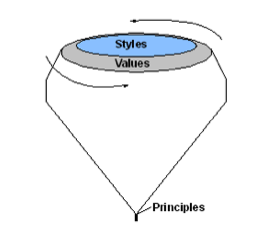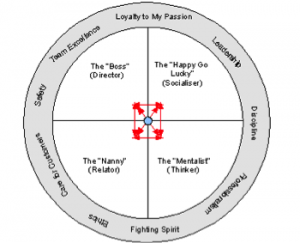Introduction – Are Leaders Born or Made?
“Character isn’t something you were born with and can’t change, like your fingerprints. It’s something you weren’t born with and must take responsibility for forming”
– Jim Rohn1
How often have you come across expressions like “John, I am impressed that you’ve actually convinced your staff to work overtime tonight. I don’t know how you do it, but you did it. You are a born leader indeed!” So are leaders really born or are they made? While most of us may take the easy way out of classifying the above as a typical ‘chicken and egg’ issue, I strongly support the latter – Leaders are made while leadership skills are honed.
In fact, the subject of leadership has received wide attention across many disciplines, ranging from management, history, economics and philosophy, just to name a few. Despite the attention, what leadership really remains elusive. Defining leadership is already not an easy task in today’s society, not to mention leadership in outdoor context.
In this essay, I will explain the type of leadership styles which I had been exposed to and currently using and some philosophies and principles that underpin my practice of outdoor leadership for my teambuilding programmes.
My First Encounter With a Principle-Based Leader
“In matters of style, swim with the current; in matters of principle, stand like a rock”
– Thomas Jefferson2
Ah Seng, my childhood friend, had always been a leader and a boy with principles amongst all the neighbourhood friends. He would follow and stand by his principles when challenged. Since young, I had always looked up to him as my ‘elder brother and a mentor’. Be it fishing, climbing coconut trees, catching creepy crawlies or even playing marbles, for an 11-year old, Ah Seng had this invisible charisma in him which can be felt whenever he did things or handled other kids.
I learnt a very important lesson during one of our fishing trips along Kallang river. While I was retrieving the first catch-of-the-day from the river and was about to kill the fish, Ah Seng held my arm and asked if I had any intention to eat it. The moment I shook my head, he snatched the fish from me with lightning fast hand and threw it back to the river. I can still recall how wide my eyes opened in disbelief! “Why did you do that?” I shouted at him. He rebuked “You only kill the fish when you have the intention to eat it!” I was dumbfounded by his explanation for a few seconds before I realised what he had explained actually made sense. Ah Seng had taught me a principle in hunting which I will never forget. – “Don’t kill a living creature when you have no intention to eat it. Learn to live and let live.”
Till date, I still adopt the same principle when I organise mini-hunting experiential trips in Indonesia. I always tell the clients that they are only allowed to shoot the wild ducks when they have the intention to eat them. Shooting for fun is a strict NO in my standard operating procedures.
Values-Based Leadership Skills
“Good leaders develop through a never-ending process of self-study,
education, training, and experience” – Manual on military leadership3
During my two and a half years involvement in national service, I had the opportunity to see leadership in a different light. As an officer cadet with the Republic of Singapore Airforce (RSAF), I practically had to eat, sleep, drink and dream the 9 RSAF core values. The 9 core values are: Loyalty to country, Leadership, Discipline, Professionalism, Fighting Spirit, Ethics, Care for Soldier, Safety and Team Excellence. I began to realise that the two ingredients ‘Principles’ and ‘Values’ are inseparable in leadership. My leadership style began to transform into a hybrid; merging the two. However, I still find something missing in this newly formed hybrid leadership whenever I lead my men. As there is a burning desire to find out about leadership and the application of it, I made a rather irrational decision: To sign on as a regular with the RSAF!
Leadership Styles
For 8 years, my goal and purpose for staying in the Singapore Armed Forces (SAF) never take a detour, they were crystal clear: To find the missing pieces to my hybrid leadership! I had gone through several leadership appointments ranging from detachment commander, platoon commander and many other leadership appointments. I had opportunities to work with different bosses and understand their leadership styles.
SAF is undoubtedly the best place to learn and be trained in leadership. After working with 7 different bosses, the answer to my quest slowly unfolded: I realised that in order to be an effective leader, I need to ‘put on different masks’ at times while hinging on strongly to my core values and principles. The first three types of leadership style which I have found out, are rather similar to what psychologist Kurt Lewin4 had defined in 1939. I have also added the fourth kind of leadership style which I called the “analytical” leader otherwise known as the “thinker” from my experiences. I will attempt to name and describe the 4 distinct leaders styles below.
- The “BOSS” (Authoritarian, Autocratic – Director Type)
When it comes to decision-making, the ‘BOSS’ makes quick and sound decisions. Once a decision is made, he will stand firm by his decision. When he says ‘1’, he means ‘1’. The ‘BOSS’ always think he is right, even when he is wrong, 99.9% of the time! This is probably due to his dominant nature. Control is important to him; he is a person with tight schedules and abhor time wasters. He normally tell people what to do rather than asking them for advice. Often than not, they are very result oriented and job focussed.
As the BOSS is very focused and direct, we can be very sure in terms of emergencies or when certain situations require on-the-spot decision, we can trust the BOSS to make a decisive decision as he is able to work under extreme pressure.
- The ‘Nanny’ (Participative, Democratic – Relators)
The ‘Nanny’ is very warm and nurturing whose main concern is trust. They are happiest when everyone around them are thriving, which is why they make such outstanding Managing Directors5.
The downside about the ‘Nanny’ is that they have a deep fear of controntation and will always feel uncomfortable and possibly overwhelmed around highly-pressured situations and people, especially the Director type. In such situations, often than not, the ‘Nanny’ might not take the lead and you will be left on your own at times.
- The “Happy-Go-Lucky” (Delegative, Laissez Faire – Socialiser)
The ‘Happy-Go-Lucky’ offers little or no guidance to group members and leave decision-making up to the group members. When you require assistance from the ‘Happy-Go-Lucky’, normally you will not get the answer straight away. Instead, he will bring you on a wild goose chase as the ‘Happy-Go-Lucky’ will ask you other things or some other irrelevant questions rather providing you with the direct solution to the problem. They want to know where you fit on the social pecking order, do you have friends and acquaintances in common? Social contacts are important to socialisers.
The ‘Happy-Go-Lucky’ tend to tell more than ask, and he is rather flexible, it may be suitable for certain subordinates who desire more free-play in exercising their problem-solving skills
- The ‘Mentalist’ (Analytic – Thinker)
The ‘Mentalist’ are very thorough, systematic and analytical leaders. They love to scrutinise the details. They are neat freaks who require things around them to be well organised, and might not function properly when things are not in order. They are very tasked-focused and regard themselves as highly efficient problem-solvers. They tend to ask a lot of questions in order to get to the bottom of things and since they have enough details after asking, they will then be confident to come up with solutions.
As the ‘Mentalist’ need more time for questions and answers, they will require a slightly longer time due to their systematic thinking process. Don’t expect them to provide you a fast solution as they require time to think. However, if time is not critical in the decision making process, the wait will be worthwhile as the ‘Mentalist’ can come up with amazing solutions at times.
The Birth of Jack “Sparrow” Chen’s Leadership Model – The “TOP” Model
“When I secure a victory, I do not repeat the tactics but respond to circumstances in limitless ways. Military tactics are similar to water… … As water shapes its flow according to the ground, an army wins by relating to enemy it faces.
And just as water retains no constant shape, in war there will be no constant condition. Thus he who can modify his tactics according to the enemy situation shall be victorious and may be called the Divine Commander”
– Sun Tze
Thanks to SAF and RSAF, I managed to find the missing puzzles to my ‘hybrid leadership’. I realise to be an effective leader, not only I need a set of values and a set of principles to guide me through, I also need to adapt to different styles in different situations. This is VERY important because even when the situation is the same, the types of people which we deal with, will be different. Thus, there is no way, we can use the same leadership style all the time.
With that, my Leadership model was born – I call it the TOP Model as shown in Figure 1. The pin at the bottom of the top stays firm on the ground, pivoting the movement of the top – Just like how our principles guide us through different situations; it is always firm and unswayed. As depicted by the top view in Figure 2, the different styles are revolved around different core values. We can adopt different styles or even combination of styles for different situations and different people (Denoted by the red bi-directional arrows in Figure 2). Notice how I have re-defined the 9 RSAF core values to suit my style as an adventure guide cum facilitator in the diagram. For example, I have changed the core value “Loyalty to country” to “Loyalty to my Passion” and “Care for Soldier” to “Care for Customers” to suit my line of work.

Figure 1: Jack “Sparrow” Chen’s “TOP” Leadership Model

Figure 2: Top view of Jack “Sparrow” Chen’s “TOP” Leadership Model Leadership Model – Leadership Styles & Values
My Leadership Style
Many years into my profession as a professional indoor and outdoor teambuilder, my style has always been a combination of the 3 leadership styles which revolved around the core values centred with a set of defined principles – i) Happiness first, safety always. ii) Shoot to kill, kill to eat. iii) Fail to plan, plan to fail.. Till date, my leadership style tend to incline towards the delegative, democratic and authocratic ones.
Often than not, I adopt a very happy-go-lucky approach when dealing with my clients. Many may wonder why. It is because “FUN” is the key word when it comes to travel. 90% of the time when people go for a tour, they are in a happy mood and want to remain happy. Thus, there is no need for me to become a director and indirectly spoiling their fun. Instead, when my clients are attempting challenging obstacles, I tend to become more participative and democratic to them. By showing encouragement to my clients in these situations, often make them feel secure. When they feel secured and set their mind to attempt the obstacles, often than not, they can complete without any difficulties. My leadership style will transform into an authoritarian one only when safety is a concern during night hunting activities because my clients’ safety is always my top priority. I have no room for errors.
How Others View My Leadership Style
Thus far, my leadership style has been widely accepted by my friends and clients. They also fedback to me in the evaluation forms that they enjoyed being led by a “Happy-Go-Lucky” tour facilitator who can manage his styles according to situations rather than one that is too bossy, too motherly or one that spends too much time thinking, neglecting them unknowningly. Therefore, I have no intention to add in the “Analytical” mode to my arsenal since all the ‘thinking and analysis’ should already been done prior the trip!
Conclusion
Leadership styles have always been evolving. Defining leaderships is a never-ending uphill task, not to mention being an outdoor leader. With so many theories and philosophies on leadership, I strongly believe, to be an effective indoor/outdoor teambuilding professional, he should be flexible to adapt different leadership styles on different situations, while maintaining a strong rootedness to his core values and principles. Only by doing so, that he can then influence and inspire his followers. At the end of the day,
“If your actions inspire others to dream more, learn more,
do more and become more, then you are a leader.”
– John Quincy Adams6
Written by:
Jack “Sparrow” Chen
Chief Planner
Happy Sparrow Pte Ltd
1 Adapted from http://www.brainyquote.com/quotes/authors/j/jim_rohn.html
2 Adapted from http://www.quotationspage.com/quotes/Thomas_Jefferson/
3 Adapted from http://www.heartquotes.net/Leadership.html
4 Adapted from http://psychology.about.com/od/leadership/a/leadstyles.htm. “In 1939, a group of researchers led by psychologist Kurt Lewin set out to identify different styles of leadership. While further research has identified more specific types of leadership, this early study was very influential and established three major leadership styles.”
5 Adapted from http://www.ecademy.com/node.php?id=120117
6 Adapted from http://www.self-improvement-mentor.com/famous-leadership-quotes.html

